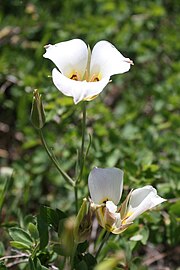
Information taken from Wikipedia®
THE SEGO LILY
They taught the Mormon pioneer immigrants to use the bulb for badly needed food. This resulted in the sego lily being formally designated as the Utah State Flower in 1911.
The following is taken from:
Utah State Flower - Sego Lily
By an act of the Utah State Legislature, approved on March 18, 1911, the sego lily was declared to be the State floral emblem (Utah Code). Kate C. Snow, President of the Daughters of Utah Pioneers, in a letter dated April 17, 1930, says that "between 1840 and 1851" food became very scarce in Utah due to a crop-devouring plague of crickets, and that "the families were put on rations, and during this time they learned to dig for and to eat the soft, bulbous root of the sego lily. The memory of this use, quite as much as the natural beauty of the flower, caused it to be selected in after years by the Legislature as the floral emblem of the State."
The sego lily was made the official state flower after a census was taken of the state's school children as to their preference for a state flower.
The sego lily, Calochortus nuttalli, has white, lilac, or yellow flowers and grows six to eight inches high on open grass and sage rangelands in the Great Basin during the late spring and early summer months. The USDA symbol is CANU3.
The sego lily was made the official state flower after a census was taken of the state's school children as to their preference for a state flower.
The sego lily, Calochortus nuttalli, has white, lilac, or yellow flowers and grows six to eight inches high on open grass and sage rangelands in the Great Basin during the late spring and early summer months. The USDA symbol is CANU3.


No comments:
Post a Comment